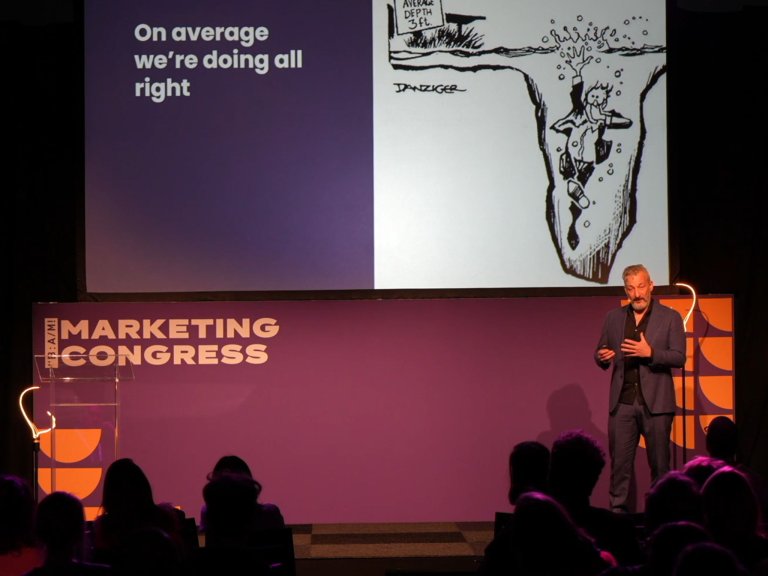Diversity in Marketing: An Eye-Opener by Johan Van Mol
Diversity in Marketing
At the BAM Marketing Congress, Johan Van Mol captivated the audience with his in-depth insights on diversity in marketing. Under the tantalising title “Beyond Assumptions: Answers from Research on Diversity in Marketing”, Van Mol not only convincingly shared why diversity is crucial in the marketing world, but also based his argument firmly on scientific research.
Aren't we doing a good job?
Van Mol opened his presentation with a tantalising question: “Aren’t we doing a good job?” and answered with: “On average, we’re doing well“. However, he emphatically added that this is with some nuance. He backs up his answer with scientific research. In it, he focuses on three categories: age, gender and ethnicity.
Van Mol points out that older age groups are severely underrepresented in the advertising world. Only 19% of Belgian ads show people aged 45 and over. This is striking, given that this group has more purchasing power than younger consumers.
Van Mol further looked at the role of gender in marketing compared to age. He showed that women are often depicted younger than men in advertisements.
The last aspect was ethnicity in marketing. Van Mol brought out that as many as 82% of people in Belgian advertisements are perceived as white, while only 18% are identified as non-white. When he compared this with the figures of ethnic diversity in our society, his conclusion was: ‘On the average, we’re doing ok‘.
These sharp insights should challenge marketers to rethink their assumptions about target groups and highlight the importance of a more inclusive approach in marketing strategies.
Diverse advertising often a checklist exercise?
The critical note struck during his presentation sheds sharp light on the perception that diverse advertising often feels like a mandatory number. This observation suggests that marketers sometimes embrace diversity only superficially, as if they are simply ticking off a checklist to meet diversity standards. As a result, the authenticity of the message can be lost, leaving the audience feeling that diversity is merely considered a liability.
Here, the four types of representation – pseudo representation, stereotypical representation, highlighting, and normalisation – provide a valuable framework to further explore this critique. Each type has its own characteristics and impact on how consumers perceive diversity. Let us briefly discuss each type:
1. Pseudo Representation
- Characteristics: This occurs when certain groups of people are present only as background characters, with no specific role or significance in the story.

- Impact: It can lead to the feeling that diversity is only treated superficially, without real involvement of diverse communities.
2. Stereotypical Representation
- Characteristics: This involves portraying people in a stereotypical way, which can contribute to perpetuating superficial and inaccurate images.
- Impact: This can lead to distorted perceptions and misconceptions, and it often reinforces prejudices.
3. Highlighting
- Characteristics: This includes highlighting a specific group when they do something positive. This approach can result in isolating that group based on performance.
- Impact: While such ads may win awards, they may run the risk of being seen as simplistic and stereotypical by the community in question.
4. Normalization
- Characteristics: This refers to incorporating diversity as an everyday, normal part of marketing narratives, without overemphasising specific groups.
- Impact: Standardisation seeks to create an inclusive representation that takes diversity for granted, making consumers feel more connected to the brand.
Understanding these representation types allows marketers to make more conscious choices when shaping their messages, with the ultimate goal of a more authentically inclusive marketing approach and thus striving for ‘normalisation‘.
The impact of diversity in advertising
The ultimate goal of marketing is undoubtedly to drive sales and generate revenue for a brand. In the quest for this goal, it is interesting to explore how diversity in advertising can affect a company’s financial success.
Recent studies and trends suggest that there is a positive correlation between diversity in advertising and consumer loyalty. When consumers can identify with the diverse characters and stories presented in ads, a deeper connection with the brand is created. This emotional engagement can result in increased brand preference and ultimately lead to more sales.
What was striking is that Van Mol not only emphasised the benefits of diversity in advertising, but also supported his argument with a calculus that showed that any opposition does not outweigh the positive impact on sales figures. The deeper connection created when consumers can identify with diverse representation can increase brand preference, which translates into tangible financial benefits for companies.
In summary, diversity in advertising can have a direct impact on sales generation by building a strong connection with a wide range of consumers. It is essential that brands not only embrace diversity as a strategic move, but also focus on cultivating an inclusive brand culture that offers depth and sincerity.
More marketing news and insights
Want more marketing news and insights? Subscribe to the marketing newsletter and stay up to date with the latest marketing news.
Marketing newsletter
- Latest marketing trends, blogs, events, ...
- Updated monthly
- Straight to your inbox



